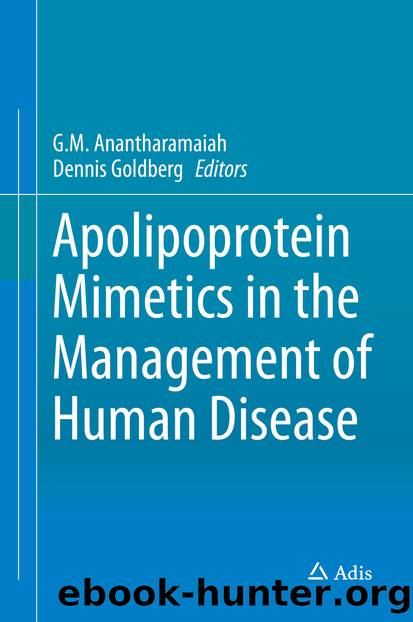Apolipoprotein Mimetics in the Management of Human Disease by G. M. Anantharamaiah & Dennis Goldberg

Author:G. M. Anantharamaiah & Dennis Goldberg
Language: eng
Format: epub
Publisher: Springer International Publishing, Cham
Genetic Deletion of ApoA-I
Previously, we showed that ApoA-I −/− mice had reduced total and HDL cholesterol (Wang et al. 2010) confirming findings by Plump et al. (1997). However, additional analysis revealed that HDL in apoA-I –/– mice had higher levels of proinflammatory HDL (p-HDL) than C57BL/6J mice (Wang et al. 2010). While the exact cause for an increase in p-HDL in these mice remains unknown, we observed that paraoxonase 1 (PON1) activity in apoA-I −/− mice was decreased in spite of the fact that total PON1 protein was increased. The cell biology of PON1 indicates that apoA-I binds PON1 which is expressed in the liver and promotes its entry into the circulation (Sorenson et al. 1999). Possibly, in the absence of apoA-I, PON1 binds to alternative partners and is therefore more susceptible to inactivation. It has been shown that among HDL subspecies, HDL particles that contain only A-I exhibits enhanced PON-1 activity compared to HDL particles that contain A-I/A-II. While the exact reason for why apolipoprotein composition in HDL particles alters PON1 activity is unknown, it is possible that apoA-I in the smaller HDL particle directly activates PON1 which apoA-I and apoA-II in larger HDL particles are less effective. Additional studies will be required to sort out such a possibility (Davidson et al. 2009; Kontush et al. 2003).
One of the common effects of dyslipoproteinemia on endothelial cell function is a shift in the balance of nitric oxide and superoxide generation by endothelial nitric oxide synthase (eNOS) (Ou et al. 2003b; Pritchard et al. 1995, 2002). To determine the effects of apoA-I deficiency on eNOS, we measured total plasma nitrite and nitrate and 3-nitrotyrosine. As anticipated, apoA-I −/− mice had lower nitrite and nitrate but increased 3-nitrotyrosine than wild-type mice. These data are consistent with the idea that the apoA-I in HDL stimulates eNOS activity (Mineo et al. 2003) and that dysfunctional HDL uncouples eNOS (Chang et al. 2014).
With evidence supporting the idea that the loss of apoA-I adversely impacts eNOS activity, we next determined whether the vascular physiology in these mice was altered. Vasodilation studies revealed that in apoA-I −/− mice, the facialis artery was unaffected, but the pulmonary artery contracted at higher doses of vasodilators compared to the responses in control mice. These data were one of the first clues that apoA-I and HDL played an important role in lung physiology (Wang 2010 #13191). To better understand the impact of apoA-I on lung physiology, we examined airway responsiveness in C57Bl/6J and apoA-I −/− mice.
Although no differences in airway resistance were observed in large airways, tissue dampening and elastance were both increased in the apoA-I −/− mice in response to methacholine challenge and to positive end-expired pressures (Wang et al. 2010). These observations indicate that the small airways are stiffer and less elastic in apoA-I –/– mice. Such changes are important for inspiration and expiration. Stiffer airways means that the lung has to work harder during inspiration. Reductions in elasticity mean that the lungs contain less stored-up energy for pushing the air out of the lung during expiration.
Download
This site does not store any files on its server. We only index and link to content provided by other sites. Please contact the content providers to delete copyright contents if any and email us, we'll remove relevant links or contents immediately.
| Automotive | Engineering |
| Transportation |
Whiskies Galore by Ian Buxton(41879)
Introduction to Aircraft Design (Cambridge Aerospace Series) by John P. Fielding(33064)
Small Unmanned Fixed-wing Aircraft Design by Andrew J. Keane Andras Sobester James P. Scanlan & András Sóbester & James P. Scanlan(32743)
Craft Beer for the Homebrewer by Michael Agnew(18140)
Turbulence by E. J. Noyes(7936)
The Complete Stick Figure Physics Tutorials by Allen Sarah(7307)
Kaplan MCAT General Chemistry Review by Kaplan(6867)
The Thirst by Nesbo Jo(6826)
Bad Blood by John Carreyrou(6552)
Modelling of Convective Heat and Mass Transfer in Rotating Flows by Igor V. Shevchuk(6391)
Learning SQL by Alan Beaulieu(6211)
Weapons of Math Destruction by Cathy O'Neil(6143)
Man-made Catastrophes and Risk Information Concealment by Dmitry Chernov & Didier Sornette(5921)
Digital Minimalism by Cal Newport;(5664)
Life 3.0: Being Human in the Age of Artificial Intelligence by Tegmark Max(5474)
iGen by Jean M. Twenge(5366)
Secrets of Antigravity Propulsion: Tesla, UFOs, and Classified Aerospace Technology by Ph.D. Paul A. Laviolette(5309)
Design of Trajectory Optimization Approach for Space Maneuver Vehicle Skip Entry Problems by Runqi Chai & Al Savvaris & Antonios Tsourdos & Senchun Chai(5011)
Pale Blue Dot by Carl Sagan(4912)
